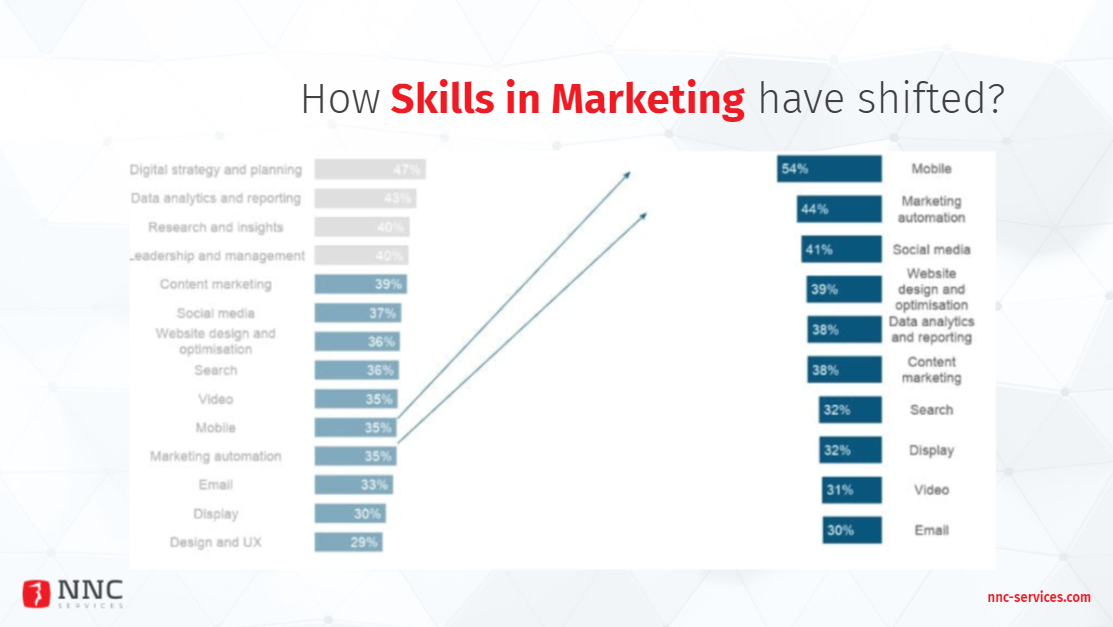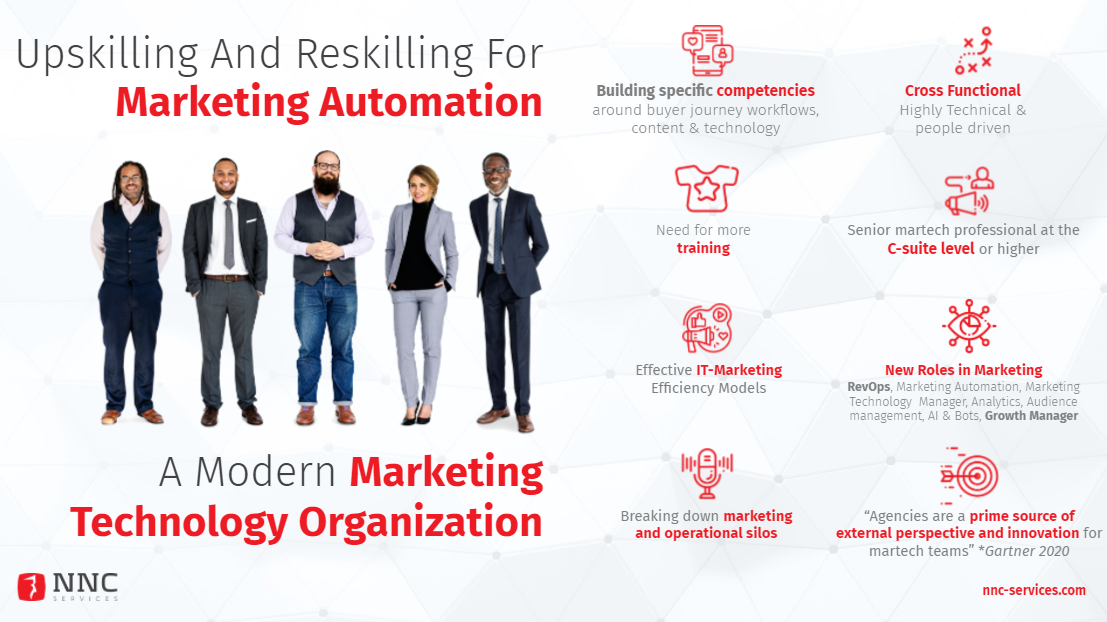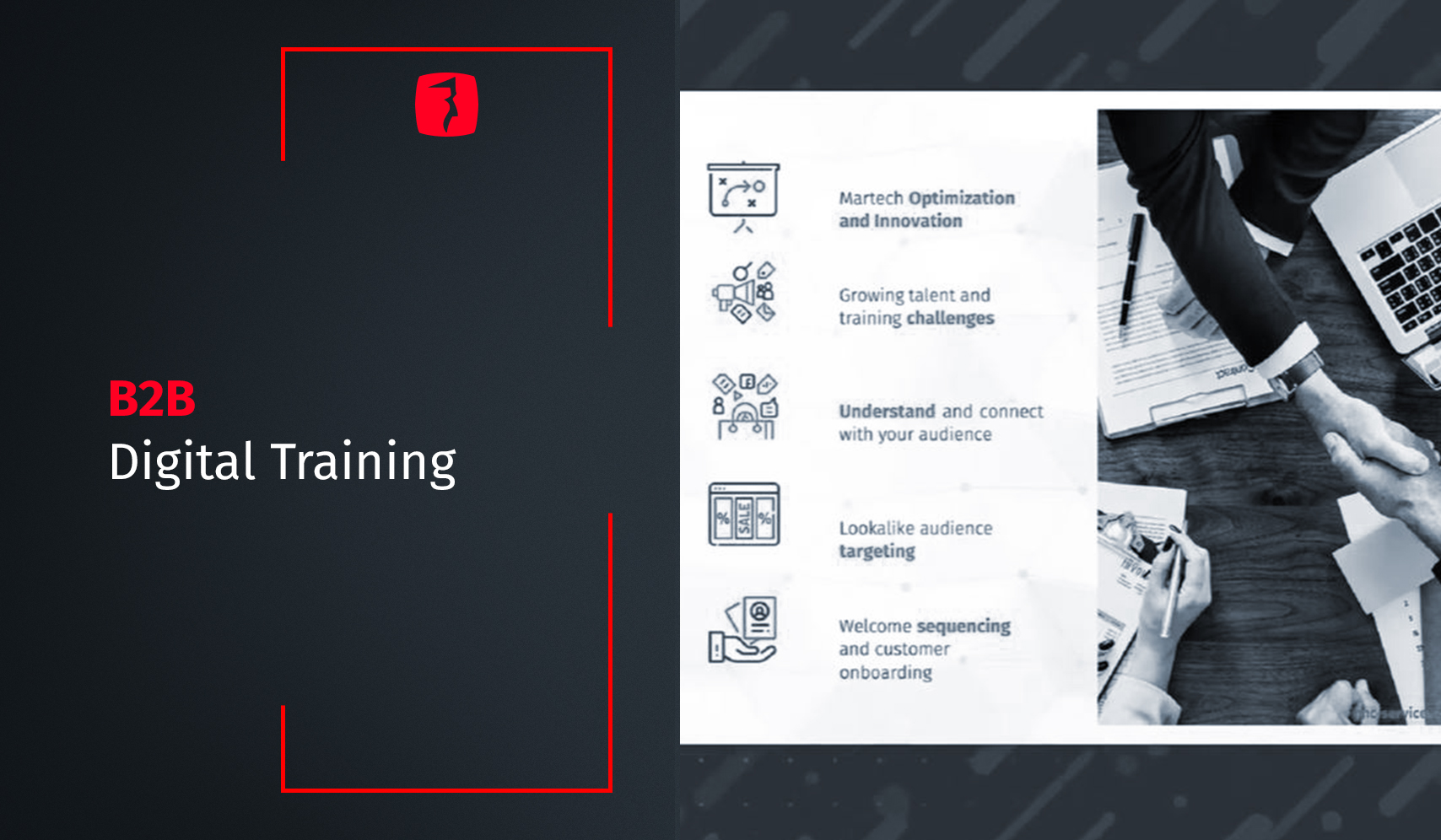B2B Digital Training
The past year has shown us the importance of digital training. More and more B2B companies today are opting for an eLearning approach when it comes to B2B digital training. Not only that, but skills in marketing have also shifted dramatically in the past couple of years. In this article, you will not only learn how companies are using B2B digital training to its’ best extent but also:
- How skills in marketing have shifted in the last couple of years
- Upskilling and reskilling
- Microlearning
- Gamification
- Learning Management Systems (LMS)
After that, we’ll go over a few conclusions about the current state of B2B digital training, and why it should be the choice for you.
How skills in marketing have shifted in the last couple of years
Marketing skills are shifting. Mobile, marketing automation, and social media skills are far more important nowadays. It seems that in the next couple of years, marketing automation will become one of the most well-paid and important skills.

Microlearning
Learning in small doses is the way of the future. Art Kohn has written in his book ‘’Brain Science: The Forgetting Curve’’ that within an hour people will, on average, forget half of all the information that was presented to them. After 24 hours, 70% of the information will be forgotten, and within a week, it will go up to 90%.
That information has made several companies head towards a microlearning approach. But what is microlearning? While there’s no official microlearning definition, all microlearning-based training shares one key characteristic: being very, very short. This could either be small learning units or short-term learning activities.
Microlearning delivers short bursts of content for learners to study at their convenience. Content can take many forms, from text to full-blown interactive multimedia, but should always be short.
Here are some microlearning content examples:
- Text (phrases, short paragraphs)
- Images (photos, illustrations)
- Videos (of the short variety)
- Audio (short snippets of speech or music)
- Tests and Quizzes
- Games (e.g. simple single-screen challenges)
Gamification
One of the best ways to learn new things is by disguising them as ‘’not work’’. By making training fun, it is much easier for people to learn new things.
Gamification is the application of game-design elements and game principles in non-game contexts. It can also be defined as a set of activities and processes to solve problems by using or applying the characteristics of game elements.
Games and game-like elements have been used to educate, entertain and engage for thousands of years. Some classic game elements are:
- Points are used as visual identifiers of progress
- Badges display achievements
- Leaderboards are used to present competitive placement
Cisco invested heavily in a social media training program for its employees and contractors in 2014. The program consisted of 47 courses. Most of the participants were confused as to where to start. Therefore, the organization planned out a gamify technique by increasing the levels of the certification. They planned out three main levels—strategist, specialist, and master—along with four sub-levels.
Ever since gamification was adopted, almost 13,000 courses have been completed by 650 employees.
Blended learning
Blended learning is an approach to education that combines online educational materials and opportunities for interaction online with webinars. It requires the physical presence of both teacher and student, with some elements of student control over time, place, path, or place.
When applied to B2B digital training, blended learning usually involves:
- A portion of the learning occurs online, with the student being able to manage the pace at which they learn
- Another portion of the learning is instructor-led, usually conducted through webinars, allowing remote learners to engage more easily
Blended learning is beneficial for B2B businesses because:
- It reduces face-to-face training costs, such as travel, accommodation, and printed training materials.
- Companies can use varying eLearning methods, such as webinars, gamification, etc., which result in better learner engagement.
- Blended learning is a more efficient and cost-effective way to train, you’ll see a quicker and greater return on investment.
- It’s also easier to track exactly who has or hasn’t, completed training
Upskilling and reskilling
Let’s take marketing automation, one of the fastest-growing skills by importance.
To give you an idea of how important marketing automation is about to become, by 2025 at least a quarter of companies will merge marketing and sales into one single department, which will report to marketing automation.
About 75% of companies are struggling with recruiting qualified marketing technology employees, especially since marketing automation is a relatively recent concept whilst also growing at an incredibly rapid rate. 55% of companies who don’t use marketing automation do so because they do not have the expertise to do so. So what can you, as a B2B organization, do?
One way is to partner up with agencies that already do this well and that can help you ramp up the skills of your team while also helping you throughout the process.
“Agencies are a prime source of external perspective and innovation for martech teams” *Gartner 2020

Learning Management Systems
A learning management system (LMS) is a software application or web-based technology used to plan, implement and assess a specific learning process. It is used for eLearning practices and, in its most common form, consists of two elements: a server that performs the base functionality and a user interface that is operated by instructors, students, and administrators.
Typically, a learning management system provides an instructor with a way to create and deliver content, monitor student participation, and assess student performance. A learning management system may also provide students with the ability to use interactive features such as threaded discussions, video conferencing, and discussion forums.
Learning Management Systems are beneficial to a wide range of organizations, including higher education institutions and corporations. The primary use of a learning management system is for knowledge management (KM). KM refers to the gathering, organizing, sharing, and analysis of an organization's knowledge in terms of resources, documents, and people skills. However, the specific role of the Learning Management System will vary according to the organization's training strategy and goals.
Popular enterprise-level Learning Management Systems include Adobe Captivate Prime, Docebo LMS, TalentLMS, iSpring Learn, and eFront.
Employee training and onboarding are some of the most common use cases for a Learning Management System in a corporate environment. In this case, the Learning Management System is used to help train new employees by providing opportunities to access training materials across various devices. New employees can be recognized when they add their knowledge and feedback, which will, in turn, help employers understand how effective the training courses are and identify areas where new employees need more assistance.
Learning Management Systems can be used for extended enterprise training purposes as well. This includes customer, partner, and member training. Customer training is common in software and technology companies where users need to be taught how a system works before they can use the new product. Providing ongoing customer training will also help improve customer experience and increase brand loyalty.
Another common use of Learning Management Systems in corporate environments is for employee development and retention. The LMS can be used to assign the necessary courses to current employees to ensure they are developing effective job skills, remain informed about product changes, and maintain relevant knowledge through new product and compliance training.
Thoughts on B2B Digital Training
Marketing skills have shifted in the past couple of years. Areas such as social media marketing, mobile marketing, or marketing automation are much more valuable now than they were a few years ago, with marketing automation well on its way to becoming the most important marketing skill you can have.
At the same time, many companies have trouble finding qualified marketing automation employees, due to the lack of people who possess such skills. There are many ways to start B2B digital training nowadays. It can be done through blended learning, microlearning, gamification, learning management systems, or even a mix of the four.
Be sure to sign up for the B2B Prospecting Academy to learn more about B2B business practices.
Latest Posts
Categories
- B2B Marketing (194)
- blog (147)
- Social media marketing (69)
- social media (53)
- Digital Marketing (43)
- Marketing (42)
- Lead Generation (39)
- Marketing Strategy (35)
- Lead Generation (33)
- B2B (30)
- Press releases (27)
- Behind the Scenes (26)
- marketing automation (26)
- Content Marketing (25)
- Marketing (21)
- Strategy (21)
- b2b tactics (19)
- AI (18)
- AI Marketing (18)
- b2b business objectives (17)
- online marketing (17)
- SEO (16)
- content marketing (15)
- B2B Campaigns (14)
- Business Growth (14)
- Business continuity (14)
- google ads (14)
- B2B Blogging (13)
- B2B business (13)
- PR Communication (13)
- b2b lead generation (13)
- PPC (12)
- b2b strategy (12)
- Marketing News (11)
- Marketing Planning (11)
- Social Media Strategy (11)
- marketing tips (11)
- B2B PPC Campaign (10)
- Conversion Rate (10)
- Employer Branding (10)
- Marketing Automation Tool (10)
- b2b social media (10)
- White papers (9)
- artificial intelligence marketing (9)
- inbound marketing (9)
- B2B companies (8)
- B2B email marketing (8)
- Fractional CMO (8)
- Twitter (8)
- crisis management (8)
- marketing automation for B2B businesses (8)
- online PR (8)
- ABM Strategy (7)
- E-books (7)
- Email Marketing (7)
- Facebook (7)
- HubSpot (7)
- Pinterest (7)
- SEO trends (7)
- b2b sales (7)
- content strategy (7)
- marketing plan (7)
- social networks (7)
- Business Development (6)
- CMO (6)
- Lead Generation Trends (6)
- Marketing Trends (6)
- SEO Strategies for B2B Companies (6)
- Webinar Recording (6)
- artificial intelligence (6)
- marketing objectives in b2b (6)
- sales prospecting (6)
- social media marketing campaign (6)
- social media trends (6)
- technology marketing (6)
- Business Intelligence (5)
- Digital Transformation (5)
- Events (5)
- Facebook page (5)
- Google AdWords (5)
- IT (5)
- Instagram (5)
- KPI measurements (5)
- Landing Page (5)
- LinkedIn (5)
- LinkedIn marketing strategy (5)
- Marketing Management (5)
- Video Content (5)
- automated marketing (5)
- b2b best practices (5)
- b2b prospecting (5)
- b2b strategies (5)
- digital communication strategy (5)
- internationalisation (5)
- marketing automation systems (5)
- trends (5)
- B2B marketing campaigns (4)
- B2B marketing inbound (4)
- Business Strategy (4)
- Cost per Lead (4)
- Digital Influence (4)
- HubSpot Certified Agency (4)
- NNC Services (4)
- Paid Advertising (4)
- Tech Startup (4)
- Tech Startup Marketing Strategy (4)
- Uncategorized (4)
- Video Marketing Strategy (4)
- b2b sales plan (4)
- best practices during crisis (4)
- brand engagement (4)
- leading marketing automation tools (4)
- market entry (4)
- marketing content (4)
- personal branding (4)
- proactive marketing (4)
- ABM sales outreach (3)
- Agile Marketing (3)
- B2B Email Marketing Campaigns (3)
- B2B Marketing Budget (3)
- B2B digital agency (3)
- B2B marketing strategy inbound (3)
- Conversion Rate Optimization (3)
- Financial (3)
- Google Analytics (3)
- Google+ (3)
- Internal Marketing (3)
- Lead Gen Automation Tools (3)
- Linkedin Groups (3)
- Marketing Automation Migration (3)
- Online Events (3)
- Pardot (3)
- Pardot to HubSpot Migration (3)
- Product Marketing (3)
- SMB international Business Models (3)
- Search Engine Optimization (3)
- Tech (3)
- Webinar (3)
- abm (3)
- b2b blogging (3)
- b2b customer aquisition (3)
- b2b growth (3)
- barriers to entry (3)
- blogging (3)
- business plan (3)
- buyer persona (3)
- customer research (3)
- demand generation (3)
- doing business abroad (3)
- employer brand (3)
- employer branding strategy (3)
- inbound leads (3)
- marketing audit (3)
- marketing automation strategy (3)
- marketing leadership (3)
- marketing portfolio audit (3)
- omnichannel marketing (3)
- online communities (3)
- online demand (3)
- outsourcing (3)
- prospects (3)
- storytelling (3)
- tech business (3)
- visual content (3)
- website optimization (3)
- 4P’s (2)
- B2B Contacts (2)
- B2B Marketing Collaterals (2)
- B2B presentations (2)
- Channel Integration (2)
- Customer-Centric (2)
- DIY business (2)
- E-Commerce (2)
- Facebook content (2)
- Go-to-Market Strategies (2)
- Hubspot Inbound (2)
- Hubspot Portal audit (2)
- Hubspot marketing portal (2)
- IT recruitment (2)
- Innovation (2)
- Integrated Marketing (2)
- Internship (2)
- Marketing Metrics (2)
- Microsoft Dynamics (2)
- PPT (2)
- Pay-per-Click (2)
- ROI (2)
- RevOps (2)
- SMART (2)
- SMB (2)
- SME (2)
- Sales Automation (2)
- Sales Automation Tools (2)
- Salesforce (2)
- Telemarketing (2)
- Tumblr (2)
- action plan (2)
- b2b planning (2)
- b2b tradeshow (2)
- b2b video marketing (2)
- banking (2)
- business communities (2)
- business management (2)
- buyer journey (2)
- buyer motivation (2)
- celebrities (2)
- client presentations (2)
- company marketing (2)
- company presentation rules (2)
- context marketing (2)
- conversion tracking (2)
- copywriting (2)
- corporate presentations (2)
- data driven (2)
- eCommerce Marketing (2)
- employee value proposition (2)
- employer value proposition (2)
- entertainment industry (2)
- entrepreneurs (2)
- free marketing tools (2)
- fundraising (2)
- gdpr (2)
- how to present in front of customers (2)
- how to write a presentation (2)
- marketing investing (2)
- marketing outsourcing (2)
- marketing segmentation (2)
- marketing upskilling (2)
- networking communities (2)
- nonprofits (2)
- online strategies (2)
- outbound marketing (2)
- outsourced marketing (2)
- ppc ads (2)
- ppc management (2)
- ppc strategy (2)
- presentation structure (2)
- product audit (2)
- product portfolio (2)
- promotion (2)
- sales enablement (2)
- sales funnel (2)
- segmentation (2)
- service marketing (2)
- slideshows (2)
- social platform (2)
- succes management (2)
- supporters (2)
- targeting (2)
- tourism industry (2)
- tradeshow attendance (2)
- tradeshow objectives (2)
- tradeshow results (2)
- tradeshow strategy (2)
- webinar tips (2)
- 2014 (1)
- ActiveCampaign (1)
- Ad Rank (1)
- AdidasOriginal (1)
- Android (1)
- B2B Case Study (1)
- B2B Digital Training (1)
- B2B SaaS startup strategy (1)
- B2B SaaS success factors (1)
- B2B content marketing trends (1)
- B2B e-mail copy (1)
- B2B e-mail marketing (1)
- B2B lead generation on LinkedIn (1)
- B2B marketing creative trends (1)
- B2B marketing on LinkedIn (1)
- BWBB (1)
- Blockchain (1)
- Blockchain Technologies (1)
- CTA button (1)
- Design Thinking Model (1)
- Direct Marketing (1)
- Dreamforce 2017 (1)
- Drip Marketing Campaign (1)
- Dynamics 365 (1)
- Dynamics 365 marketing (1)
- Dynamics Marketing (1)
- Eastern Central Europe (1)
- Eastern Europe (1)
- Emotional B2B Marketing (1)
- Employee Feedback (1)
- Event management (1)
- External Marketing (1)
- Facebook Apps (1)
- Facebook marketing (1)
- Freemium SaaS (1)
- Go-to-Market (1)
- Google Ad Grant (1)
- Google Ads statistics (1)
- GoogleAdGrant (1)
- HR planning (1)
- Hubspot Outbound (1)
- IT marketing (1)
- IT outsourcing (1)
- IT service price (1)
- Intel (1)
- LeadGeneration (1)
- LinkedIn B2B marketing (1)
- LinkedIn for business growth (1)
- Machine Learning (1)
- Market Entry Strategy (1)
- Market Research (1)
- Marketing Results (1)
- Marketing frameworks (1)
- Marketing vs Sales (1)
- Marketo (1)
- Medium Companies (1)
- Microsoft Dynamics 365 (1)
- NGO (1)
- Networking (1)
- Organizational culture (1)
- PPC statistics (1)
- PPC stats (1)
- Personalized messages (1)
- Pictures (1)
- Podcast SEO (1)
- Price (1)
- Recruitment Marketing (1)
- Revenue operations (1)
- Romanian content marketers (1)
- SaaS (1)
- SaaS startup growth (1)
- Salesforce Partners (1)
- SharpSpring (1)
- Small Business (1)
- Social Proof (1)
- StopWar (1)
- Tactics (1)
- Target (1)
- Tech events (1)
- Template (1)
- Till Hahndorf (1)
- Types of Google Ads (1)
- Ukraine (1)
- VirginAmerica (1)
- Voice Search SEO (1)
- Work alternative (1)
- Youtube Ads (1)
- ads setting (1)
- app (1)
- artists (1)
- b2b benchmark (1)
- b2b buyer (1)
- b2b buying process (1)
- b2b buying trends (1)
- b2b customers (1)
- b2b marketing vs sales (1)
- b2b modeling (1)
- b2b price (1)
- b2b viral campaign (1)
- benghmarking (1)
- best practices for B2B marketing on LinkedIn (1)
- brand advocates (1)
- business (1)
- business growth course (1)
- buyer behaviour in b2b (1)
- buyer persona template (1)
- buyers (1)
- call to action (1)
- clients (1)
- cold-calling (1)
- company (1)
- competition (1)
- creative marketing strategies for B2B (1)
- customer segmentation (1)
- cybersecuritystrategy (1)
- dan schawbel (1)
- detailed buyer persona (1)
- differentiators (1)
- downloadable resources (1)
- e-mail campaigns (1)
- e-mail message and copy (1)
- employer brand experience (1)
- employer of choice (1)
- environmental marketing (1)
- fans (1)
- gdpr benefits (1)
- gdpr benefits for marketing (1)
- go-to-market channels (1)
- green marketing (1)
- growth marketing (1)
- hotel (1)
- how to find leads (1)
- how to sell (1)
- how to use LinkedIn for B2B marketing (1)
- human resources (1)
- iOS (1)
- inbound marketing services (1)
- inbound marketing vs outbound marketing (1)
- international business (1)
- investment in marketing (1)
- investors (1)
- jamie oliver (1)
- lead generation results (1)
- leads (1)
- letter writing (1)
- like (1)
- market price (1)
- marketing benchmarking (1)
- marketing flywheel (1)
- marketing goals (1)
- marketing investments (1)
- marketing letters (1)
- marketing message (1)
- marketing objectives (1)
- marketing strategy for 2022 (1)
- mobile (1)
- mobile marketing (1)
- music (1)
- new business opportunities (1)
- online reputation (1)
- peak-end rule in B2B marketing (1)
- personal branding tips (1)
- personell issues (1)
- photos (1)
- podcast (1)
- positive employer brand (1)
- ppc click fraud (1)
- price debate (1)
- price negociation (1)
- pricing (1)
- pricing stratey (1)
- product cost (1)
- product price (1)
- promote (1)
- publicity vs persuasion in B2B marketing (1)
- recession tactics (1)
- roadmap (1)
- sales (1)
- script (1)
- seo practices (1)
- service price (1)
- services (1)
- setting objectives (1)
- setting the price (1)
- smart bidding (1)
- social channels (1)
- social media for B2B thought leadership (1)
- social networking (1)
- social recruitment (1)
- startup (1)
- subscribers (1)
- sustainability (1)
- tailored experience (1)
- talent pool (1)
- tech hub (1)
- tech professionals (1)
- thought leadership content (1)
- thought leadership on social media (1)
- tools (1)
- updates (1)
- using characters in B2B advertising (1)
- viral campaignes (1)
- viral marketing (1)
- viral videos (1)
- visual (1)
- voice search optimization (1)







.png?width=100&name=cover%20blogposts%20sm%20website%20(6).png)
